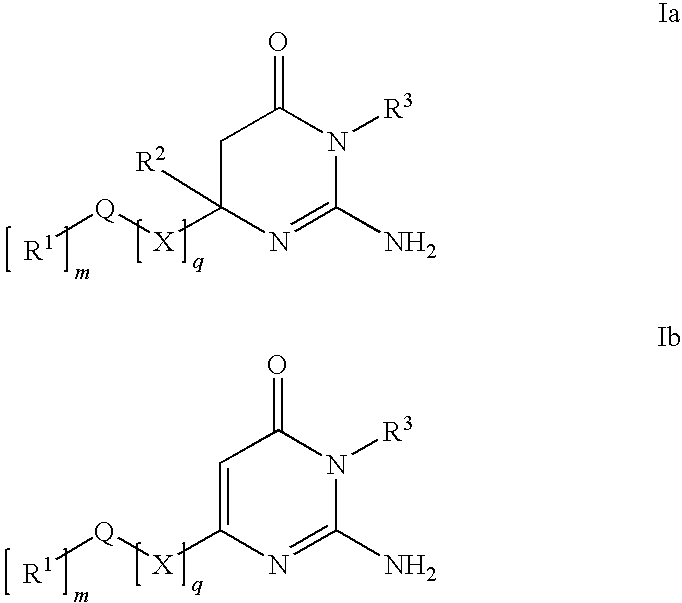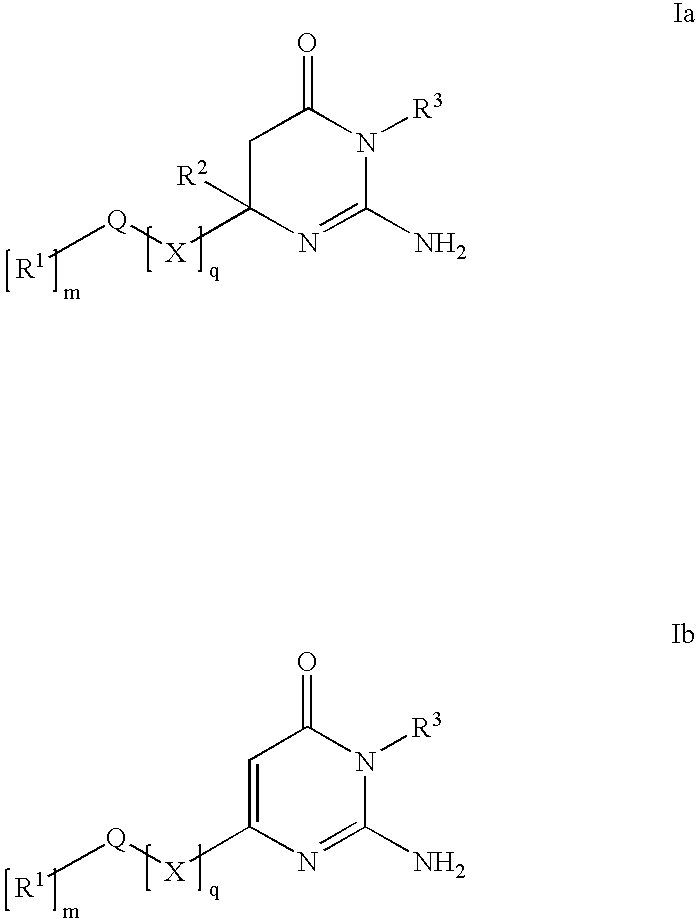Substituted Amino-Pyrimidones and Uses Thereof
a technology of aminopyrimidone and substituted aminopyrimidone, which is applied in the direction of biocide, chemical treatment enzyme inactivation, drug composition, etc., can solve the problems of high prevalence of alzheimer's disease in this population, and the problem of increasing the problem of diseas
- Summary
- Abstract
- Description
- Claims
- Application Information
AI Technical Summary
Benefits of technology
Problems solved by technology
Method used
Image
Examples
example 1
2-Amino-6-(3-bromo-phenyl)-6-methyl-5,6-dihydro-3H-pyrimidin-4-one (Scheme 1, B)
[0661]
[0662]To a solution of guanidine HCl salt (0.35 g, 3.72 mmol) and sodium methoxide (0.16 g, 4.09 mmol) in NMP (2 mL) was added (E)-3-(3-bromo-phenyl)-but-2-enoic acid ethyl ester (Scheme 1, A) (0.5 g, 1.86 mmol) and the reaction was subjected to microwaves at 200° C. for 15 min. The NMP was removed under reduced pressure to yield a dark amber syrup. To this was added acetonitrile:water:TFA (75:25:0.1, 10 ml) and the resulting precipitate was removed. The filtrate was purified using RP-HPLC (tR=8.33). The combined purified fractions were lyophilized to give the title compound as a light tan powder (0.21 g, 40%). 1H NMR (300 MHz, DMSO-d6): δ 1.64 (s, 3H); 3.14 (d, 1H, J=16.5 Hz); 3.34 (d, 1H, J=16.5 Hz); 7.44 (m, 2H); 7.55 (m, 1H); 7.64 (s, 1H). m / z (ES) 282 M+.
[0663]To one skilled in the art, it is appreciated that the olefin used in the cyclization may be one of a diverse set of esters, for example...
example 2
2-Amino-6-(3′-methoxy-biphenyl-3-yl)-3,6-dimethyl-5,6-dihydro-3H-pyrimidin-4-one (Scheme 2, I)
[0666]
[0667]General Suzuki Conditions Method A: To a solution of 2-amino-6-(3-bromo-phenyl)-3,6-dimethyl-5,6-dihydro-3H-pyrimidin-4-one (Scheme 2, H) (47 mg, 0.132 mmol) in 1.5 mL 7:3:2 1,2-dimethoxyethane:water:ethanol was added was added cesium carbonate (129 mg, 0.396 mmol), 3-methoxyphenylboronic acid (26 mg, 0.172 mmol), and dichlorobis(triphenylphosphine)palladium(II) (4.6 mg, 0.0065 mmol). The reaction was subjected to microwaves for 15 min. at 150° C. after which the solvents were removed under a stream of nitrogen. To this brown gum was added ACN:water:TFA (75:25:0.1, 2.0 ml) and the resulting precipitate removed. The filtrate was purified using RP-HPLC (Ret. time: 14.2 mins). The combined purified fractions were lyophilized to give the title compound as a white powder (25 mg g, 43%). 1H NMR (300 MHz, DMSO-dr / TFA-d): δ 1.71 (s, 3H); 3.13 (s, 3H); 3.21 (d, 1H, J=16.5 Hz); 3.59 (d, 1...
example 3
6-(3′-methoxy-1,1′-biphenyl-3-yl)-6-methyl-2-(methylamino)-5,6-dihydropyrimidin-4(3H)-one
[0668]
[0669]The HPLC purification of Example 2 resulted in isolation of the title compound as a white powder (4.7 mg, 10%). 1H NMR (300.132 MHz, DMSO) d 1.77 (s, 3H), 3.04 (s, 3H), 3.13 (d, J=16.6 Hz, 1H), 3.48 (d, J=16.6 Hz, 1H), 3.85 (s, 3H), 6.99 (dd, J=10.0 Hz, J=2.4 Hz, 1H) 7.23 (m, 2H), 7.42 (m, 2H), 7.52 (t, J=7.7 Hz, 1H), 7.65 (d, J=7.5 Hz, 1H), 7.73 (s, 1H); m / z (ES+) M+1=324; LCMS tR=1.7 min.
2-Amino-6-(3-bromo-phenyl)-3,6-dimethyl-5,6-dihydro-3H-pyrimidin-4-one (Example 4, Scheme 2, H) was Prepared as Follows
(E)-3-(3-Bromo-phenyl)-but-2-enoic acid tert-butyl ester (Scheme 2, C)
[0670]
[0671]To a −78° C. stirred solution of tert-butyldimethylphosphonoacetate (21.9 mL, 0.111 mol) in THF (150 mL) was added n-BuLi in hexanes (1.6 N, 72.0 mL, 0.116 mol) and the reaction stirred at −78° C. for 10 min. To this mixture was added 3′-bromoacetophenone (13.4 mL, 0.100 mole) and the reaction allowed...
PUM
| Property | Measurement | Unit |
|---|---|---|
| Volume | aaaaa | aaaaa |
| Volume | aaaaa | aaaaa |
| Mass | aaaaa | aaaaa |
Abstract
Description
Claims
Application Information
 Login to View More
Login to View More - R&D
- Intellectual Property
- Life Sciences
- Materials
- Tech Scout
- Unparalleled Data Quality
- Higher Quality Content
- 60% Fewer Hallucinations
Browse by: Latest US Patents, China's latest patents, Technical Efficacy Thesaurus, Application Domain, Technology Topic, Popular Technical Reports.
© 2025 PatSnap. All rights reserved.Legal|Privacy policy|Modern Slavery Act Transparency Statement|Sitemap|About US| Contact US: help@patsnap.com



